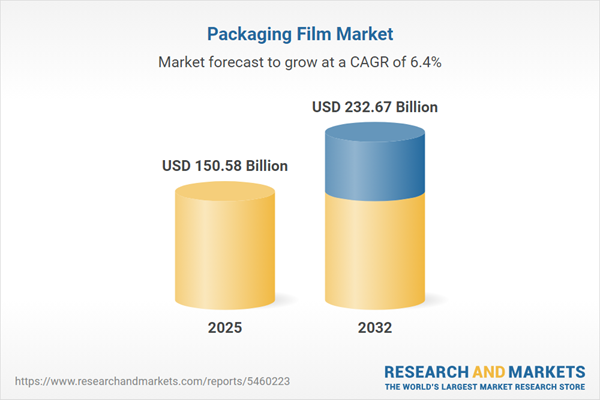Speak directly to the analyst to clarify any post sales queries you may have.
The packaging film market is rapidly evolving as manufacturers, brand owners, and supply chain participants respond to changing regulatory pressures, sustainability goals, and material innovations. Decision-makers face a complex landscape requiring agile strategies and insightful analysis for sustained growth.
Market Snapshot: Packaging Film Market Size and Growth Overview
The packaging film market grew from USD 141.29 billion in 2024 to USD 150.58 billion in 2025. It is projected to maintain a CAGR of 6.43%, with revenues anticipated to reach USD 232.67 billion by 2032.
Scope & Segmentation of the Packaging Film Market
Industry leaders benefit from a comprehensive breakdown of the packaging film sector, enabling strategic focus along diverse supply and value chains.
- Material Types: Biodegradable options such as polylactic acid and starch-based films; Polyamide; Polyester (Polyethylene Terephthalate); Polyethylene (high-density, linear low-density, low-density); Polypropylene (biaxially oriented, cast); Polyvinyl Chloride.
- Applications: Consumer packaging (gift, home care, household, personal care); Food packaging (bakery, dairy and frozen, fruits and vegetables, meat and seafood, snack foods); Industrial packaging (agriculture, construction, electronics); Medical packaging (diagnostic, devices, pharmaceuticals).
- Structural Formats: Monolayer; Multilayer (four to six layer, seven or more layer, two to three layer).
- Process Technologies: Extrusion film methods (blown film—double, single, triple bubble, and cast film); Non-extrusion (calendered, laminated film).
- Packaging Forms: Bags (gusseted, spout); Pouches (flat bottom, stand up, zipper); Roll stock; Sheets; Wrappers.
- Regional Markets: Americas (North America, Latin America); Europe, Middle East & Africa (Europe, Middle East, Africa); Asia-Pacific (China, India, Japan, Australia, South Korea, Indonesia, Thailand, Malaysia, Singapore, Taiwan).
- Key Companies Analyzed: Amcor plc; Berry Global Group, Inc.; Sealed Air Corporation; Mondi plc; Huhtamäki Oyj; UFlex Limited; Mitsubishi Chemical Corporation; Sonoco Products Company; Constantia Flexibles GmbH; Coveris Holdings S.A.
Key Takeaways for Senior Decision-Makers
- Material and structural innovations are enabling tailored solutions for demanding end uses, advancing both sustainability and performance.
- Biodegradable films are gaining market share, driven by stringent environmental regulations and escalating consumer eco-consciousness.
- Smart manufacturing, including sensor integration and real-time analytics, is improving product consistency and enabling agile customization.
- Collaboration among resin producers, converters, and brand owners is accelerating co-innovation and improving alignment with evolving regulatory frameworks.
- Strategic sourcing and supply chain resilience have become increasingly important for stakeholders navigating complex trade policies and regional dynamics.
Tariff Impact: Strategic Responses to US Trade Measures
Recent United States tariff measures on imported polymers and finished films have driven up input costs and prompted reevaluation of sourcing strategies. Companies are mitigating these impacts through dual-sourcing, domestic investments, and collaborative forecasting. These moves aim to ensure consistent supply for critical segments, while industry advocacy seeks exclusions and flexibility within policy frameworks. High-value and niche applications with premium functionalities have emerged as focal points for sustaining profitability amid shifting trade environments.
Methodology & Data Sources
This report employs a blend of in-depth secondary research, such as industry publications, patent filings, and regulatory documents, together with primary interviews involving senior executives in R&D and supply chain operations. Quantitative analysis underwent stringent validation against corporate disclosures and market data to ensure accurate mapping of market dynamics and trends.
Why This Report Matters to Packaging Film Stakeholders
- Enables strategic planning by delivering granular insights into emerging technologies, new materials, and evolving application trends across global supply chains.
- Equips decision-makers to proactively address challenges posed by regulation, sustainability pressures, and fluctuating trade policies.
Conclusion
The packaging film sector is at a pivotal juncture, shaped by advances in materials science, supply chain transformation, and regulatory change. Senior leaders equipped with strategic industry insights are well positioned to capitalize on new opportunities and drive long-term value creation.
Additional Product Information:
- Purchase of this report includes 1 year online access with quarterly updates.
- This report can be updated on request. Please contact our Customer Experience team using the Ask a Question widget on our website.
Table of Contents
3. Executive Summary
4. Market Overview
7. Cumulative Impact of Artificial Intelligence 2025
Companies Mentioned
The companies profiled in this Packaging Film market report include:- Amcor plc
- Berry Global Group, Inc.
- Sealed Air Corporation
- Mondi plc
- Huhtamäki Oyj
- UFlex Limited
- Mitsubishi Chemical Corporation
- Sonoco Products Company
- Constantia Flexibles GmbH
- Coveris Holdings S.A.
Table Information
| Report Attribute | Details |
|---|---|
| No. of Pages | 188 |
| Published | November 2025 |
| Forecast Period | 2025 - 2032 |
| Estimated Market Value ( USD | $ 150.58 Billion |
| Forecasted Market Value ( USD | $ 232.67 Billion |
| Compound Annual Growth Rate | 6.4% |
| Regions Covered | Global |
| No. of Companies Mentioned | 11 |









